Tastes and odors in water – What are the causes and how can they be treated?
Pure water is colorless, tasteless, odorless, and free from any and all contaminants. But water is rarely found in its pure state. In fact, water that smells or tastes funny is a primary reason people turn to bottled water, which is expensive for you and taxing on the environment. Millions of barrels of oil are used each year to produce and transport bottled water, and billions of plastic bottles are added to our landfills. Plus, bottled water is simply filtered tap water, in many cases. Instead of dealing with the expense, inconvenience and guilt that come with buying bottled water, get your water tested, and install the appropriate water treatment system for clean and refreshing water right in your home.
The first step to better water is to find out what might be wrong with your water. Water that tastes or smells bad could be an indication that it contains one or more contaminants. The good news is that there are many water treatment options available to solve a variety of water problems. Rather than trying to figure out the best solution on your own, contact a water treatment expert to have your water tested and help you decide what is best for you.

Common Tastes & Odors in Water
ODOR #1: “Rotten Egg” Smell in Water
If there is a rotten egg or sulfur smell in your water, the most likely cause is hydrogen sulfide gas. Hydrogen sulfide is a colorless, corrosive gas from decaying plant material that occurs naturally in some groundwater. It is also often present in wells drilled in shale or sandstone, near coal deposits or oil fields. Sulfur-reducing bacteria, which flourishes in hot water, can also change natural sulfates in water to hydrogen sulfide, causing the classic “rotten egg” odor. Hydrogen sulfide can affect the taste of food and beverages. If the concentration of hydrogen sulfide is high enough, it can also leave that rotten egg odor on hair and clothing washed in the water and can accelerate the corrosion of metal parts in appliances. If you suspect your water contains hydrogen sulfide, contact a water professional for a water test.
ODOR #2: Metallic Taste and Odor
Water that tastes like metal can indicate the presence of iron, copper, manganese, zinc or other metals. Naturally occurring in groundwater, iron and manganese can affect the taste and odor of water as well as cause stains on things the water contacts.
Copper and zinc in water can be from an aging water distribution system or the corrosion of copper plumbing and brass fittings in your home. If you notice a metallic smell or taste to your water, it could contain copper or zinc. Though not harmful in trace amounts, large quantities of both zinc and copper can be harmful to humans.
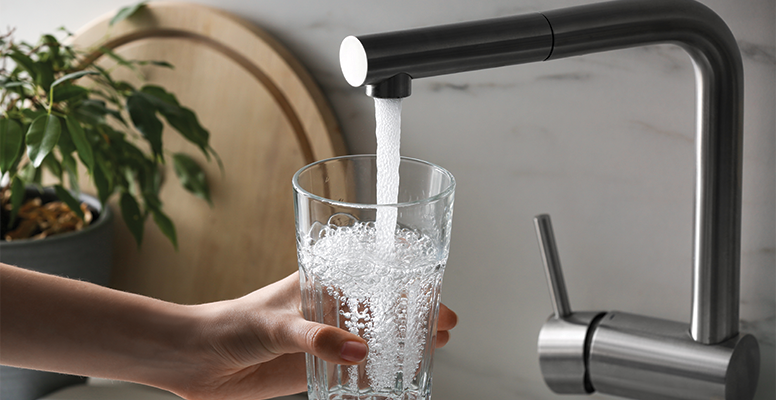
ODOR #3: Earthy or Musty Taste and Odor
Sometimes people with well water or water from surface water supplies say their water has an earthy or musty taste or odor. This could be the result of decayed vegetation and other organic matter and are typically associated with different forms of algae. While the smells and odors are not toxic, they are unpleasant and can be offensive at very low concentrations. A water test will help determine what is causing the bad tastes and odors, and the appropriate water treatment equipment can be installed to solve the problem.
ODOR #4: Chlorine or Bleach Smell in Water
Another common complaint is water that smells and tastes of chlorine or bleach. This is typically found in city water supplies or where chlorine is used to disinfect a water supply. Many object to the smell of chlorine when showering, and chlorine can greatly affect the taste and smell of drinking water and foods and drinks made with water. Although chlorine is needed to disinfect water, and it should remain in the water when it travels through the distribution system, once it is in your home, the chlorine is no longer needed.
ODOR #5: Sewage Smell in Lexington KY

“Residents across the western portion of Fayette County expressed disgust over a waft of a sewage smell in their neighborhood, and now the city is sharing how it plans to dilute the smell long-term. For more than a year, hundreds of residents have complained about the putrid smell from nearby wastewater treatment plants. The Lexington water quality director says there’s a plan in place to fix it.” – LEX18 [READ ARTICLE]
Water quality specialists and experts in Lexington are hard at work addressing odor concerns from residents. And while they cannot fully identify the cause of the odor, they assure the public the odor is non-toxic, just annoying. Residents in various neighborhoods have been complaining since the Summer of 2023, so Mayor Linda Gorton signed an emergency contract with Webster Environmental Services to determine the odor cause and air testing. The division is working on a variety of projects worth nearly $2 million, including odor and sanitary control.
The city is looking at three areas of concern: the Cumberland Hill Neighborhood, the Meadowthorpe neighborhood, and the Pinnacle Neighborhood. All three are located near Wastewater treatment plants. As a result, Lexington’s Water Quality department has instituted the following procedures to mitigate the odor:
- SMOKE IT OUT: The next phase for the division of water quality is finding specific problem spots where odor is leaking from pipes into areas that affect residents. Because they can’t see the odor with a naked eye, the city will be pumping smoke to track the sewer scent. The smoke is non-toxic, but people with heart problems and breathing issues should take precautions. The smoke testing involves pushing non-toxic white smoke into manholes to identify cracked or broken sewer pipes. If a broken pipe is found, the Division of Water Quality will notify the property owner, and the property owner is usually responsible for repairs. [READ ARTICLE]
- CLEANING THE SYSTEM: Lexington’s Water Quality division has completed a thorough cleaning of the odor control systems at both of the city’s wastewater treatment plants.
- HIRING EXPERTS: They have also hired an environmental firm to test the systems that are currently in place and recommend upgrades that will provide the best results on the quickest timeline. The experts are to determine the cause. Some of those theories include lack of rainfall, equipment and less stormwater in the sanitary sewer system because of an overhaul of the system to protect water quality. But unsure of exactly what is causing the stench, the city has entered into an emergency contract with Webster Environmental Associates to help identify sources of the odor and testing conditions. [READ ARTICLE]
- ACTIVATED CARBON: They are also treating air with activated carbon in the same way one would treat water on a filter that has been hooked to a kitchen sink. The first installation of activated carbon is meant to pull out contaminants from the air in order to release a more neutralized odor. It also depends on how concentrated the odor is though; if highly concentrated the activated carbon effects will not last long. [READ ARTICLE]
- A CAUSTIC SCRUBBER: A caustic scrubber is another item that’s on the agenda. Caustic scrubbers are essential industrial equipment used to neutralize acidic gases in exhaust streams. They employ a caustic solution—typically sodium hydroxide (NaOH)—as a scrubbing medium, converting harmful acidic gases into harmless salts.
- MINERAL OIL: The water division has used other chemicals to safely test their systems but are now utilizing mineral oil with a motorized odor control fan.
SOLUTIONS TO ODORS:
Solution 1: Sulfur Guard Backwashing Filter
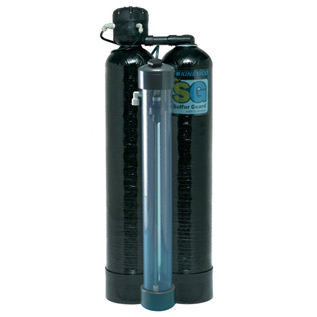
Sulfur Guard filters provide a turnkey remedy for handling foul-smelling “rotten egg” water. Unlike other systems that use multiple treatment stages and are expensive, cumbersome and complex to maintain, there’s not much to do with a Kinetico Sulfur Guard™ filter but enjoy your water. Dual tanks accommodate higher flow rates needed in multi-person and larger homes. Moving water is the power source, not electricity, so operation is simple and reliable. There are no timers or computers to set, adjust, repair or replace.
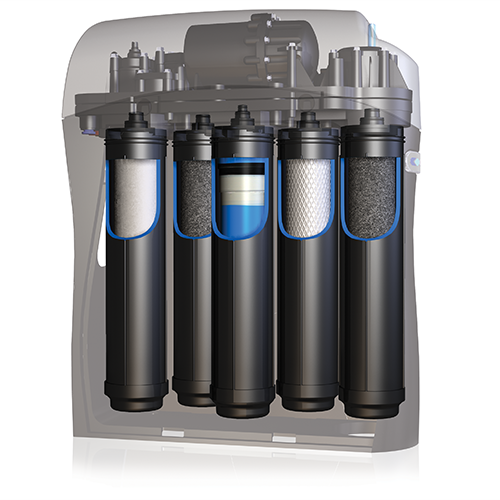
Solution 2: K5 Drinking Water Station with VOC Guard
Kinetico’s K5 Drinking Water Station® with VOC Guard, our best reverse osmosis system, includes unique features and is customizable to suit your specific treatment needs. Reverse osmosis is a water filtration process that forces water through a semi-permeable membrane. The membrane has holes small enough to reject anything larger than a water molecule making reverse osmosis very effective for contaminant removal. The process is known for producing water of the highest quality. RO systems are good for both city water and well water. The K5 significantly reduces more contaminants than any other drinking water treatment unit with 99% contaminant removal. The K5 is certified by WQA to NSF/ANSI Standard 58 for PFOS/PFOA removal.
Solution #3: Powerline™ PRO Series Filters
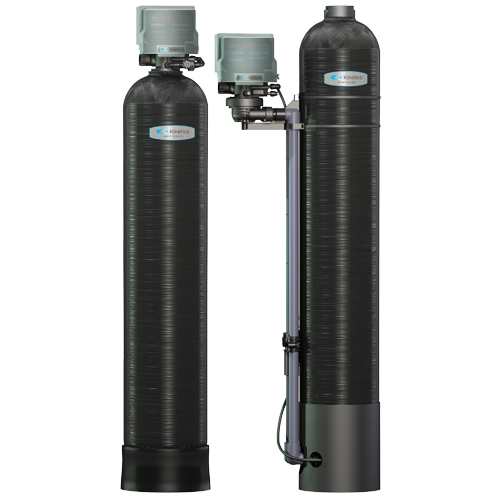
Powerline™ PRO Series protects appliances, fixtures and clothing from iron staining, and eliminate the rotten-egg odor caused by hydrogen sulfide gas in your water with these electric, single-tank systems. Fully programmable control valve can be set up using handheld devices such as smartphones and tablets, via local Bluetooth® connection. Two available tank sizes and three unique media blends provide flexibility for installation.
Solution #4: Neutralizer
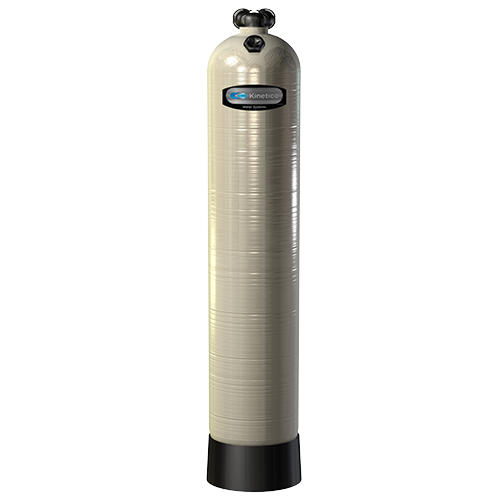
The Neutralizer is a simple, single-tank option for neutralizing the pH of your water, helping to eliminate the problems associated with acidic water. No timers or computers to set, adjust, repair or replace. Combined backwash and service cycles reduce maintenance and pressure drop. Large tanks provide greater capacity, with easy-access top port for simpler media replenishment.
Solution #5: Chloramine Reduction System (CRS)
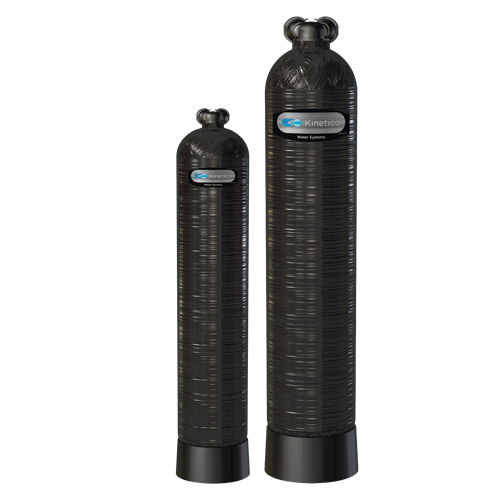
An increasing number of water treatment plants are using chloramine, instead of chlorine, to disinfect water. Like chlorine, chloramine has an unpleasant taste and odor and can also make water more corrosive. If you currently have a dechlorination system, it will not effectively remove chloramine from your water. NOW FEATURING Kinetico’s exclusive Chloraban® media, the Kinetico CRS systems are the only residential systems certified by the Water Quality Association for whole-house reduction of chloramine.
Solution #6: Carbon Backwashing Filter
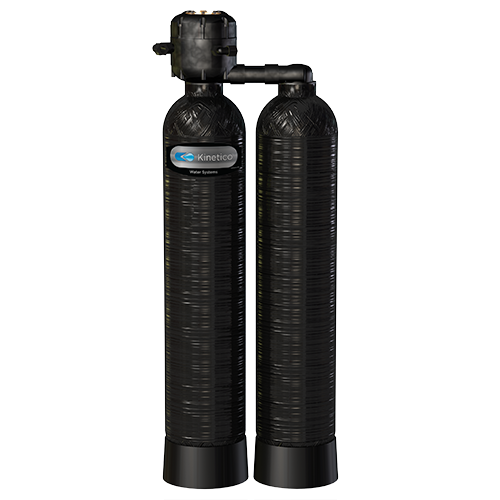
The Carbon Backwashing Filter refreshes water by removing chlorine, taste and odor. The filter offer maximum performance providing the highest quality water for your home. The dual tanks that filter the arsenic from your water will be periodically replaced when necessary by your Kinetico water professional, so you don’t have to do a thing. Systems meter water and backwash based on actual usage. You won’t waste water on unnecessary backwashing. Our non-electric control valve provides on-demand backwashing.
In conclusion,
Water quality can vary from home to home, neighborhood to neighborhood and region to region. Many things can cause water to smell and/or taste bad. To fully understand what is going on with the water in your home, schedule a water test. Once you know the causes, you can determine the best water treatment plan of action.







